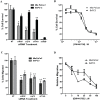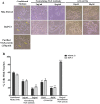Blocking Nerve Growth Factor Signaling Reduces the Neural Invasion Potential of Pancreatic Cancer Cells
- PMID: 27792755
- PMCID: PMC5085053
- DOI: 10.1371/journal.pone.0165586
Blocking Nerve Growth Factor Signaling Reduces the Neural Invasion Potential of Pancreatic Cancer Cells
Abstract
Perineural invasion (PNI) is thought to be one of the factors responsible for the high rate of tumor recurrence after surgery and the pain generation associated with pancreatic cancer. Signaling via the nerve growth factor (NGF) pathway between pancreatic cancer cells and the surrounding nerves has been implicated in PNI, and increased levels of these proteins have been correlated to poor prognosis. In this study, we examine the molecular mechanism of the NGF signaling pathway in PNI in pancreatic cancer. We show that knocking down NGF or its receptors, TRKA and p75NTR, or treatment with GW441756, a TRKA kinase inhibitor, reduces the proliferation and migration of pancreatic cancer cells in vitro. Furthermore, pancreatic cancer cells migrate towards dorsal root ganglia (DRG) in a co-culture assay, indicating a paracrine NGF signaling between the DRGs and pancreatic cancer cells. Knocking down the expression of NGF pathway proteins or inhibiting the activity of TRKA by GW441756 reduced the migratory ability of Mia PaCa2 towards the DRGs. Finally, blocking NGF signaling by NGF neutralizing antibodies or GW441756 inhibited the neurite formation in PC-12 cells in response to conditioned media from pancreatic cancer cells, indicating a reciprocal signaling pathway between the pancreatic cancer cells and nerves. Our results indicate that NGF signaling pathway provides a potential target for developing molecularly targeted therapies to decrease PNI and reduce pain generation. Since there are several TRKA antagonists currently in early clinical trials they could now be tested in the clinical situation of pancreatic cancer induced pain.
Conflict of interest statement
The authors have declared that no competing interests exist.
Figures






References
-
- Siegel RL, Miller KD, Jemal A (2016) Cancer statistics, 2016. Ca: a Cancer Journal for Clinicians 66: 7–30. - PubMed
-
- Hirai I, Kimura W, Ozawa K, Kudo S, Suto K, et al. (2002) Perineural invasion in pancreatic cancer. Pancreas 24: 15–25. - PubMed
-
- Takahashi T, Ishikura H, Motohara T, Okushiba S, Dohke M, et al. (1997) Perineural invasion by ductal adenocarcinoma of the pancreas. J Surg Oncol 65: 164–170. - PubMed
MeSH terms
Substances
Grants and funding
LinkOut - more resources
Full Text Sources
Other Literature Sources
Medical

